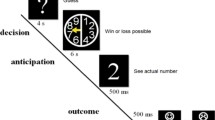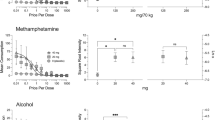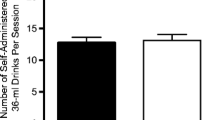Abstract
Three dosage levels of barbiturate and three of amphetamine were compared with a placebo, all under three set conditions (neutral, stimulant and sedative). Drug reactions were assessed by performance measures and by self-rating scales administered at a series of standard times following the drug administration in order to provide drug-time-response patterns.
The self-rating scales yielded clear dosage-time-response curves for both drugs at all dosage levels. There was no systematic evidence of set or drug-by-set-effects. Research strategies in human drug studies are discussed.
Similar content being viewed by others
References
Agnew, N. M.: The relative value of self report and objective tests in assessing the effects of amphetamine. J. Psychiat. Res. 2, 85–100 (1964).
Beecher, H. K.: Some remarks on quantitative studies of subjective responses to drugs. In: Psychopharmacology. A Review of Progress 1957–1967, pp. 973 to 977. D. H. Efron (ed.). Washington: U.S. Government Printing Office 1968.
Broadbent, D. E.: Perception and communication. London: Pergamon Press 1958.
Bruner, J. S.: Going beyond the information given, in contemporary approaches to cognition. Cambridge: Harvard Univ. Press 1957.
Cole, J. O.: Peeking through the double blind. In: Psychopharmacology. A review of progress 1957–1967, pp. 979–984. D. H. Efron (ed.). Washington: U.S. Government Printing Office 1968.
Efron, D. H. (Ed.): Psychopharmacology. A review of progress 1957–1967. Washington: U.S. Government Printing Office 1968.
Evans, W. O.: The psychopharmacology of the normal human: trends in research strategy. In: Psychopharmacology. A review of progress 1957–1967, pp. 1003 to 1011. D. H. Efron (ed.). Washington: U.S. Government Printing Office 1968.
Farber, I. E.: The things people say to themselves. Amer. Psychol. 18, 185–197 (1963).
Fisher, S., Balter, M.: Personal communication (1962).
— 3, 149–156 (1956).
Frankenhaeuser, M., Post, B., Magdahl, R., Urangsjoe, B.: Effects of a depressant drug as modified by experimentally-induced expectation. Percept. Mot. Skills. 18, 513–522 (1964).
General Aptitude Test Battery, Section III. U.S. Department of Labor, Bureau of Employment Security. Washington: U.S. Government Printing Office 1958.
Gottschalk, L. A.: Some problems in the evaluation of the use of psychoactive drugs, with or without psychotherapy, in the treatment of non-psychotic personality disorders. In: Psychopharmacology. A Review of Progress 1957–1967, pp. 255–269. D. H. Efron (ed.). Washington: U.S. Government Printing Office 1968.
Guilford, J. P.: The nature of human intelligence. New York: McGraw-Hill 1967.
Hebb, D. O.: The organization of behavior. New York: Wiley 1949.
Hawkins, D. R., Pace, R., Pasternaek, B., Sandifer, M. G.: A multivariant psychopharmacologic study in normals. Psychosom. Med. 23, 1–17 (1961).
Janke, W., Debus, G.: Experimental studies on anti-anxiety agents with normal subjects: Methodological considerations and review of the main effects. In: A Review of Progress 1957–1967, pp. 205–230. D. H. Efron (ed.). Washington: U.S.Government Printing Office 1968.
Lasagna, L., Meier, P.: Clinical evaluation of drugs. Ann. Rev. Med. 9, 347–353 (1958).
Lehmann, H. E.: Problems in controlled clinical evaluation. In: Psychopharmacology. A Review of Progress 1957–1967, pp. 949–971. D. H. Efron (ed.). Washington: U.S. Government Printing Office 1968.
Lindquist, E. F.: Design and analysis of experiments in psychology and education. New York: Houghton Mifflin 1953.
Miller, G. A., Galanter, E., Pribam, K. M.: Plans and the structure of behavior. New York: Henry Holt 1960.
Newell, A., Simon, H. A.: The logic theory machine: a complex information processing system. IRE Transactions on Information Theory. IT-2/3, 61–79 (1958).
Osgood, C. E.: Motivational dynamics of language behavior. In: Nebraska Symposium on Motivation, pp. 348–424. M. R. Jones (ed.). Lincoln: Univ. Nebr. Press 1957.
Ross, S., Cole, J. O.: Psychopharmacology. Ann. Rev. Psychol. 11, 415–438 (1960).
—, Krugman, A. D., Lyerly, S. B., Clyde, D. I.: Drugs and placebos: a model design. Psychol. Rep. 10, 383–392 (1962).
Schachter, S., Singer, J. E.: Cognitive, social and physiological determinants of emotional state. Psychol. Rev. 69, 379–399 (1962).
Weiss, B., Laties, V. G.: Enhancement of human performance by caffeine and the amphetamines. Pharmacol. Rev. 14, 1–36 (1962).
Author information
Authors and Affiliations
Rights and permissions
About this article
Cite this article
Agnew, N.M., Ernest, C.H. Dose-response and biased set study of an amphetamine and a barbiturate. Psychopharmacologia 19, 282–296 (1971). https://doi.org/10.1007/BF00401945
Received:
Revised:
Issue Date:
DOI: https://doi.org/10.1007/BF00401945




